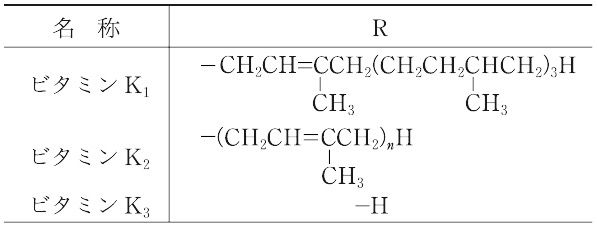ビタミンK1 化学特性,用途語,生産方法
解説
フィロキノンともいう.血液凝固を促進する脂溶性ビタミン.血液凝固に必要な因子のⅡ因子(プロスロンビン)やⅦ因子,Ⅸ因子,Ⅹ因子の生合成に関係する.凝固(Koagulation,独語)のKをとって命名された.1939年,E.A. Doisy(ドイジー)らは,アルファルファ(牧草)と腐敗魚粉から2種類のビタミンK物質を分離して,ビタミン K1,K2 と命名した.これらの物質がキノン構造を有することを推定して,数多くのキノノイドについて検討し,2-メチル-1,4-ナフトキノンが有効であることを明らかにした. "これが現在ビタミン K3 とよばれているものである.いずれも水に不溶,有機溶媒に可溶.光,アルカリなどによって容易に分解される.空気,湿気に対しては比較的安定である.なお,出血剤ジクマロールはビタミンKのアンチビタミンである.
"これが現在ビタミン K3 とよばれているものである.いずれも水に不溶,有機溶媒に可溶.光,アルカリなどによって容易に分解される.空気,湿気に対しては比較的安定である.なお,出血剤ジクマロールはビタミンKのアンチビタミンである. ビタミン K1:フィロキノン,フィトナジオン,2-メチル-3-フィチル-1,4-ナフトキノンともいう.C31H46O2(450.17).鮮黄色の油.融点-20 ℃.紫外線照射により変性する紫外線.照射により殺菌された牛肉でネズミを飼育すると,ビタミンK欠乏症を示した.森北出版「化学辞典(第2版)
ビタミン K1:フィロキノン,フィトナジオン,2-メチル-3-フィチル-1,4-ナフトキノンともいう.C31H46O2(450.17).鮮黄色の油.融点-20 ℃.紫外線照射により変性する紫外線.照射により殺菌された牛肉でネズミを飼育すると,ビタミンK欠乏症を示した.森北出版「化学辞典(第2版)
生理作用
脂溶性ビタミンのひとつ。傷や内出血などで血を固める血液凝固作用に不可欠なビタミン。葉野菜など緑の濃い野菜類、海藻類、豆製品などに多く含まれる。体内で乳酸菌を作り、骨からカルシウムが排出されるのを防ぎ、骨を丈夫に保つ働きをもつほか、グルタミン酸の代謝向上、骨粗鬆症(こつそしょうしょう)の予防、生理痛の緩和、体のpH(ペーハー)バランスの調整などに作用があるとされる。
骨にカルシウムが沈着するのを助けたり、血液の凝固因子(ぎょうこいんし)を合成するのに必要な栄養素で、骨粗鬆症(こつそしょうしょう)の治療薬としても認可されています。ビタミンKが不足すると、骨に十分なカルシウムが取り込めなくなって、もろくなるのをはじめ、鼻血(はなぢ)や大腸炎(だいちょうえん)、乳児の脳内出血(のうないしゅっけつ)が起こりやすくなるなどのトラブルが生じます。ビタミンKは1日に1.0~1.5mgが腸内の微生物によって合成されるため、あまり欠乏症の心配はありません。抗生物質を長期服用している人は、腸内細菌の働きが弱って、体内での生成量が不足するケースがあります。逆に血液の抗凝固剤を服用中の人は、ビタミンKの摂取を制限されるので注意してください。ビタミンKは納豆やシュンギク、クレソンなどに多く含まれており、成人1日の目安量は男女とも150μgです。
生物学の機能
Both vitamins K3 and K4 may
produce hyperbilirubinemia and kernicterus in neonates as well as hemolysis in neonates and
glucose-6-phosphate–deficient patients. In fact, the only advantage of vitamins K3 and K4 over
vitamin K1 is that whereas absorption of vitamin K1 requires the presence of bile, absorption of
vitamins K3 and K4 does not, because they are absorbed via a passive process directly from the
intestine. This may be a slight advantage for patients with cholestasis or severe pancreatic
dysfunction. Only vitamin K1, however, is appropriate therapy for bleeding associated with warfarin
and superwarfarin anticoagulation. Vitamin K2 is not used therapeutically.
作用機序
Vitamin K antagonists, such as warfarin, produce their effect on blood coagulation by interfering
with the cyclic interconversion of vitamin K and vitamin K 2,3-epoxide. Vitamin K is
an essential cofactor necessary for the posttranslational carboxylation of the glutamic acid residues
on the N-terminal portions of the specific clotting factors (II, VII, IX, and X) and anticoagulant
proteins, such as protein C. This γ-glutamyl carboxylation results in a new amino acid,
γ-carboxyglutamate, which through chelation of calcium ions causes the proteins to undergo a
conformational change. This change in tertiary structure allows the four vitamin K–dependent
clotting factors to become activated and bind to the negatively charged phospholipid membranes
during clotting cascade activation.
薬物動態学
The half-life of vitamin K1 is quite short—only 1.7 hours via the intravenous route and 3–5 hours via
the oral route. When given orally, vitamin K1 is absorbed directly from the proximal small intestine in
an energy-dependent and saturable process that requires the presence of bile salts. These kinetic
features argue for administration in divided doses rather than larger, single daily doses. The typical
starting point for adults with drug-induced hypoprothrombinemia is 2.5 to 10 mg of vitamin K1 orally,
repeating in 12 to 48 hours if needed. In cases of ingestion of long-acting superwarfarin
rodenticides (e.g., brodifacoum), therapy may be 125 mg/day for weeks or months. Practically
speaking, because vitamin K1 is dispensed as 5-mg tablets, superwarfarin-poisoned patients may
require 10 to 30 tablets every 6 hours.
臨床応用
Vitamin K1 (phytonadione, Mephyton) is
the form of vitamin K most often used therapeutically. Vitamin K1 is safe for use in infants, pregnant
women, and patients with glucose-6-phosphate deficiency.
安全性プロファイル
Moderately toxic by
subcutaneous route. An experimental
teratogen. When heated to decomposition it
emits acrid smoke and irritating fumes.
ビタミンK1 上流と下流の製品情報
原材料
準備製品